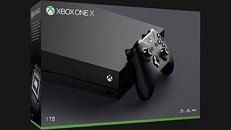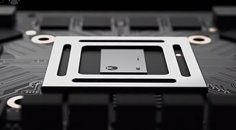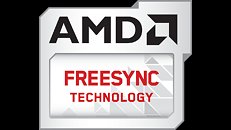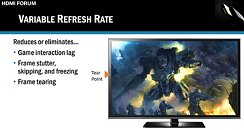Sunday, March 11th 2018

AMD's FreeSync Coming to Xbox Console Family
It's finally happening - a variable refresh rate (VRR) technology is hitting the mainstream. Microsoft's Larry Hyrb and AMD's Antal Tungler announced the coming of the feature to the Xbox family of consoles yesterday, on an Xbox live stream (follow the link for the correct time stamp). This move likely marks a turning point in the VRR landscape, as this is likely just the beginning of FreeSync support on consoles - while the PlayStation side of the equation has remained silent until now, the usage of AMD-powered graphics on that console also marks an opportunity for FreeSync to increase its market impact even more. Where does this leave NVIDIA's G-Sync? Well, it depends on the market development, but one thing is for sure: FreeSync already is a royalty-free solution, and is now in the process of receiving a much more relevant consumer base than G-Sync could ever dream of.
FreeSync 2 + HDR support was touted for the Xbox One X from its introduction, but has been absent post launch. Now, users on the Xbox Insider fast ring should receive an update in the next few days that delivers the technology to their Xbox One X and Xbox One S games consoles. Users of the original Xbox One will also receive FreeSync support, albeit on its gen 1 iteration - which is still the more relevant today. All in all, this likely means that console games will move away from their locked 30 or 60 FPS frame rates in favor of variable refresh rates - which, when paired with a FreeSync-capable monitor (or TV set) will bring much improved graphics smoothness.Of course, FreeSync being introduced to TVs is still a pretty barren landscape, so news of G-Sync's demise may be a Mark Twain-esque exaggeration. However, with 2018 TV sets moving to support the HDMI 2.1 standard with its built-in VRR technology means the opportunity cost for actual FreeSync implementation in TVs is very low. Should this scenario actually come to pass, then yes, G-Sync may have its days counted.
Sources:
Xbox YouTube Channel, via Forbes
FreeSync 2 + HDR support was touted for the Xbox One X from its introduction, but has been absent post launch. Now, users on the Xbox Insider fast ring should receive an update in the next few days that delivers the technology to their Xbox One X and Xbox One S games consoles. Users of the original Xbox One will also receive FreeSync support, albeit on its gen 1 iteration - which is still the more relevant today. All in all, this likely means that console games will move away from their locked 30 or 60 FPS frame rates in favor of variable refresh rates - which, when paired with a FreeSync-capable monitor (or TV set) will bring much improved graphics smoothness.Of course, FreeSync being introduced to TVs is still a pretty barren landscape, so news of G-Sync's demise may be a Mark Twain-esque exaggeration. However, with 2018 TV sets moving to support the HDMI 2.1 standard with its built-in VRR technology means the opportunity cost for actual FreeSync implementation in TVs is very low. Should this scenario actually come to pass, then yes, G-Sync may have its days counted.




43 Comments on AMD's FreeSync Coming to Xbox Console Family
At this point in Time
Vulkan (Mantle) is used in the Following titles:
The Talos Principle
Dota 2
Doom
vkQuake
Roblox
Star Citizen (dropped DX12 in favor of Vulkan)
Mad Max (Vulkan support beta added for Linux release)
Ballistic Overkill
Ashes of a Singularity Escalation
vkDoom 3 (Vulkan port released in August 2017 as part of Doom3 BFG
Wolfenstein II The New Colossus
X4 Foundations
X-Plane 11
Rust
Serious Sam VR
Warhammer 40k Dawn of War III
X Rebirth VR
F1 2017 (Linux)
Rise of the Tomb Raider (linux)
Escape From Tarkov (Support planned worked in one patch but was removed later testing still on going)
I hope thst list gets bigger because it seeams ms csnt code for nothing with DX 12 lol
That's why.They have polaris and bulldozer.
The reason being that conceptually , sure , Vulkan borrowed many ideas and concepts from Mantle , concepts which are used in every other modern graphics API including DirectX 12 and Metal which I am sure you wouldn't claim they are the same thing. But other than that , there aren't many particularities that remained untouched from Mantle and transitioned to Vulkan , even things such as error checking which seems basic at first but end up making a noticeable difference .Secondly , as it happens my research went much further than an article on pcworld. I happened to have written some simple stuff using Vulkan and I have first hand experience with why it isn't the same as Mantle.
when you take a newer API place into an older API's compiler and it works that would generally tell you just how similar it really is. Then again with multiple friends working at various game and 3D studios I will take there word for it that Vulkan is basically a better Mantle. Most of them typically use DX still however since its tied to the Microsoft ecosystem and then just port over to PS4 GNM / GNMX
The way you seem to look at it is , if there are enough similarities between the two such as syntax and whatnot then they are the same. Why do you think Khronos has been able to convert Vulkan code to Metal in such a penalty-free manner through MoltenVK ? Because they are all indeed very similar , but certainly not the same. Your definition of "same" is way too broad to act as a valid point.I guess you would indeed trust your friends more than a random person on the internet. But so would I, trust myself, and disagree with that knowing to have worked with these things first hand.
I fail to see much benefit from Freesync in a locked 30 fps scenario. Plus it still requires a Freesync 2 capable TV. Good luck finding those. And they say G-Sync monitors are scarce lol.
I guess according to your reasoning than a game engine is no longer the same with a revision and a game must be different after a patch.
Fundamentally the code base has not changed. You don't have to believe me but Ill take an industry professional working for AAA studios over a guy thats fiddled with some code. While I don't do coding in general I do however do 3D modeling / texturing and shader work. Which requires things to work a certain way for game engines to process the data correctly with proper function calls.
When it all it takes to make a Vulkan code base work with the Mantle API is to change two letters in front of the damn function calls that says it all. This was known day one Vulkan didn't really change anything they took the core of Mantle using the same function calls and features and changed two letters. Thus forming the framework and base code for Vulkan. Its been rehashed to death. The information is out there and those who wanted to learn Vulkan were fiddling like you with Mantle to begin with because the code base once again was the same.
SO I guess we can agree to disagree even if the evidence / studios / employees / coders / AMD / Khronos screams Mantle was the base for Vulkan. We are also seriously off topic at this point.
And to top it all off, I was able to pay for my video card in a few months simply by having it mine while I wasn't playing. Handy.
All that said, I do hope nvidia someday supports freesync. Gsync is *vastly* better (it's much more stringent requirements are shown in its price premium though) but freesync is, well, free. Having support for both can only help the consumer.
Adaptive sync is quite benefital below 30 or 60hz, but far less noticible above 100hz. It will be quite helpful to console owners since it will allow designers to target frame rates higher then 30 without having to be able to manage 60fps (which seems to be a common issue with consoles). And even 40-45 fps is a noticeable step up from 30fps for a fast paced game.Gsync requires actual hardware, it's not a software only solution. That's the primary reason for the higher cost.